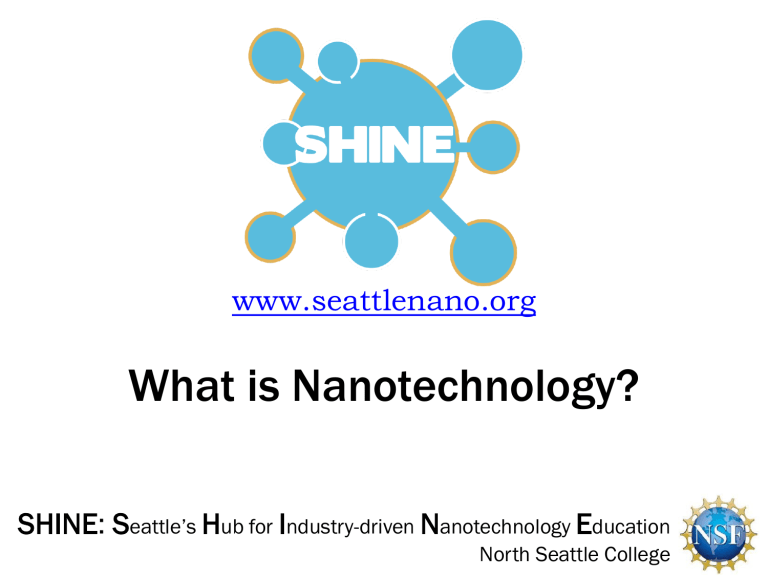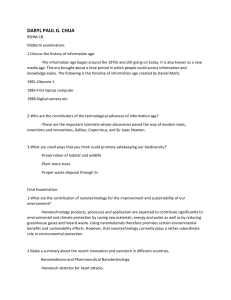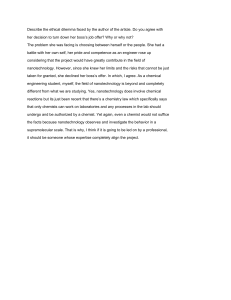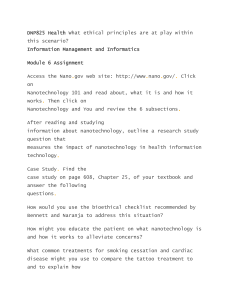
www.seattlenano.org What is Nanotechnology? SHINE: Seattle’s Hub for Industry-driven Nanotechnology Education North Seattle College What is Nanotechnology? Nanotechnology is…. • the control of matter on the atomic level • the ability to build using atoms as building blocks • the manufacture of novel materials with novel properties What is a nanometer? • 1 nm = 10-9 m = 0.000000001 m = one billionth of a meter What is a nanostructure? • Structure with at least one dimension < 100 nm Seattle’s Hub for Industry-Driven Nanotechnology Education 2 3 Why Study Nanoscience and Nanotechnology? Nanoscience: The study of fundamental principles of nanostructures between bulk and atomic properties. Nanotechnology: The application of nano-structures into useful devices. Seattle’s Hub for Industry-Driven Nanotechnology Education 4 The Very Beginnings… 500 – 1400 – Stained Glass 800 - 1600 – Nanoparticles in pottery 1200 - 1700 – Damascus Steel swords ~1910 – Particle sizes described in “nanometers” 1959 – Feynman’s speech: “The principles of physics, as far as I can see, do not speak against the possibility of maneuvering things atom by atom” Seattle’s Hub for Industry-Driven Nanotechnology Education 5 Then… 1970 – “Nanotechnology” coined (Taniguchi) 1981 – First atoms seen (Binnig and Rohrer, STM) 1986 – Engines of Creation, the Coming Age of Nanotechnology by Richard Drexler “Nanotechnology is the principle of atom manipulation atom by atom, through control of the structure of matter at the molecular level. It entails the ability to build molecular systems with atom-byatom precision, yielding a variety of nanomachines” Seattle’s Hub for Industry-Driven Nanotechnology Education 6 Now… 7 Why “Nano” is Interesting Particles are small • • • • • High surface-to-volume ratio React differently Act differently (new properties) Interact with light differently Are on the scale of small biological structures Quantum Mechanics meet Classical Mechanics Interesting “new” structures Interesting materials with nanoparticles embedded Seattle’s Hub for Industry-Driven Nanotechnology Education 8 Surface Area and Energy Surface energy increases with surface area Large surface energy = instability Surface area vs particle size Seattle’s Hub for Industry-Driven Nanotechnology Education Surface atoms (%) Driven to grow to reduce surface energy diameter (nm) C. Nutzenadel et al., Eur. Phys. J. D. 8, 245 (2000). 9 Physical Structure Physical Property What are the structural differences on the nanoscale? • High percentage surface atoms • Spatial confinement • Reduced imperfections What properties are affected? What properties can we tune? Seattle’s Hub for Industry-Driven Nanotechnology Education 10 Melting Points Melting point (K) Lower melting point for nanostructures <100 nm Surface energy increases as size decreases Particle diameter (nm) Ichimose, N. et al. Superfine Particle Technology Springer-Verlag London, 1992. Seattle’s Hub for Industry-Driven Nanotechnology Education 11 Electrical Properties Band gap increases as particle size decreases E Metal Insulator Seattle’s Hub for Industry-Driven Nanotechnology Education Semi-conductor NP Semi-conductor 12 Particles & Light Particles interact differently with light 1X 220X 5000X 20,000X Militaries Study Animals for Cutting-Edge Camouflage. James Owen in England for National Geographic News March 12, 2003, Proc. R. Soc. Lond. B (1999) 266, 1403-1411 Structures are smaller than wavelength of visible light • Photonic Crystals • Surface Plasmon Resonance • Quantum Dot Fluorescence Seattle’s Hub for Industry-Driven Nanotechnology Education 13 Optical Properties Surface Plasmon Resonance • • • • Interaction of light with metallic nanoparticle surfaces Coupling of free electrons and incident light Localized coherent oscillation of electrons Tunable optical properties of nanostructures; depends on size, shape, composition, and environment Seattle’s Hub for Industry-Driven Nanotechnology Education 14 Optical Properties: Quantum Dots Band gap increases as particle size decreases E Metal Insulator Semiconductor 50 nm QD Seattle’s Hub for Industry-Driven Nanotechnology Education 10 nm QD 15 Size: Biological Structures 2 nm diameter ~5 nm thick ~10 nm diameter 5000 nm diameter ~50 – 100 nm diameter Seattle’s Hub for Industry-Driven Nanotechnology Education 16 Unique Structures Buckyballs Zeolites Carbon Nanotubes Seattle’s Hub for Industry-Driven Nanotechnology Education 17 Image References Slide 3 The Scale of Things. [Online file]. 09 Nov 2015. <http://www.nist.gov/pml/wmd/metric/upload/doe-scale-of-things-18-jan05.pdf>. Slide 5 The South rose window of Notre Dame Cathedral, ca 1250. Polychrome lustreware bowl, 9th C, Iraq, British Museum. Damascus saber. [Online images]. 02 Nov. 2015. <http://www.nano.gov/timeline> Slide 7 Process Engineer at Nano3 Facility. [Online image]. 02 Nov. 2015. <http://ucsdnews.ucsd.edu/pressrelease/nsf_locates_national_nanotechnolo gy_coordinated_infrastructure_site_at_uc_s> Female Scientist Pipetting. [Online image]. 02 Nov. 2015. <http://www.nnin.org/news-events/spotlights/nanotechnology-careers> Slide 9 C. Nutzenadel et al., Eur. Phys. J. D. 8, 245 (2000). Slide 11 Ichimose, N. et al. Superfine Particle Technology Springer-Verlag London, 1992. Seattle’s Hub for Industry-Driven Nanotechnology Education 18 Image References Slide 13 Militaries Study Animals for Cutting-Edge Camouflage. James Owen in England for National Geographic News. March 12, Proc. R. Soc. Lond. B (1999) 266, 1403-1411 (Penn State NACK Educational Resources, 2009). Slide 14 Motl, N.E. et al., Chem. Soc. Rev., 43, 3823 (2014). Slide 15 Witze, A., DAZZLING Dots. (Cover Story). Science News 188.1 (2015): 22-25. Academic Search Premier. Web. 9 Nov. 2015. Red blood cells. [Online image]. 09 Aug. 2010. <http://www.topnews.in/health/files/Red-Blood-Cells.jpg>. Slide 16 DNA double helix. [Online image]. 09 Aug. 2010 <http://www.biojobblog.com/uploads/image/dna_500.jpg>. Lipid bilayer. [Online image]. 09 Aug. 2010 <http://upload.wikimedia.org/wikipedia/commons/f/f0/Lipid_bilayer_section .gif>. Seattle’s Hub for Industry-Driven Nanotechnology Education 19 Image References Slide 16 ATP synthase. [Online image]. 09 Aug. 2010. Adapted. <http://www.er.doe.gov/bes/scale_of_things.html>. Flu virus. [Online image]. 09 Aug. 2010. <http://www.chm.bris.ac.uk/webprojects2006/Kelly/influenzafigure1.jpg> Carbon nanotube: <http://en.wikipedia.org/wiki/File:Carbon_nanotube_armchair_povray.PNG> Slide 17 Buckyball: <https://en.wikipedia.org/wiki/Buckminsterfullerene#/media/File:Buckminste rfullerene-perspective-3D-balls.png> Zeolite: <http://chemeducator.org/sbibs/s0004003/spapers/430114wv.htm> To access additional educational resources please visit: www.seattlenano.org This material is based upon work supported by the National Science Foundation under Grant Number 1204279. Any opinions, findings, and conclusions or recommendations expressed in this material are those of the author(s) and do not necessarily reflect the views of the National Science Foundation. 20




